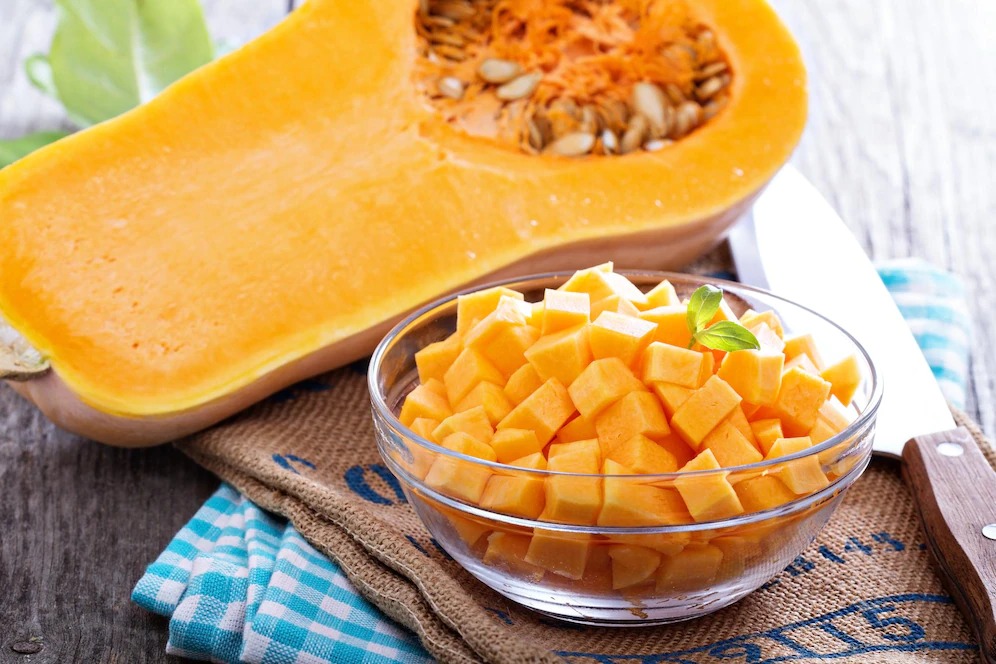 There are several ways to prepare butternut squash. You can cut it into dice, roast it or boil it. Here are a few simple methods to help you get started. Before cooking, cut the squash in half. Then scoop out the seeds. Then cut the squash into slices as thick as you desire.
There are several ways to prepare butternut squash. You can cut it into dice, roast it or boil it. Here are a few simple methods to help you get started. Before cooking, cut the squash in half. Then scoop out the seeds. Then cut the squash into slices as thick as you desire.
Preparing butternut squash for cooking
Table of Contents
Before you begin cooking with butternut squash, you should prepare it by peeling it. The squash’s skin is thin and smooth and will easily peel off. To remove it, start at the stem and work down in long strips. Next, you can use a knife to cut away the skin from the base.
If you don’t want to deal with peeling, you can cut the butternut squash into small chunks and bake them in the oven. The squash will soften in about half an hour, and you won’t even need to use oil. To cook butternut squash with no oil, you can use the superheated steam that’s produced by boiling water. This method will cook the squash quickly, but it won’t add any flavor. The result will be a bland flavor and an undercooked texture.
When cutting a butternut squash, make sure that you have a sharp knife and a sturdy surface. A dull knife can cause an accident. Also, make sure you have a sturdy surface because a soft butternut squash can break easily. And don’t forget to wash the squash thoroughly!
Peeling a butternut squash is an easy task if you’re prepared to use a knife. Peeling the flesh can take a bit of practice, but it’s essential if you plan on using the squash for cooking. You can cut a butternut squash into cubes by placing it on a cutting board. Then, rub it with olive oil and season with salt and pepper.
Butternut squash can be used in a variety of recipes. It can be cooked whole, mashed, roasted, or steamed. Its seeds are edible and can be used just like pumpkin seeds.
Cutting butternut squash
To cut butternut squash, hold the squash on its side and slice it vertically, starting at the center. Slice one side of the squash at a time, letting the first half cool before continuing. Once the squash is cool, cut it into cubes. Carefully remove the squash from the heat, and save the seeds.
To start, use the largest and sharpest knife available to cut the squash. A chef’s knife or cleaver is ideal. Peel off the skin as carefully as possible, and use your thumb behind the knife guard to keep it from slipping. The next step is to use a vegetable peeler or a metal spoon to scoop out the seeds.
Butternut squash can be cut into a variety of shapes, including rings, long sticks, cubes, and large halves. You can also roast the seeds, which are edible. A slice should be about 1/4″ thick. Butternut squash is delicious cooked in a variety of ways. It can also be sautéed in a pan or roasted on an outdoor grill.
Butternut squash can be stored for weeks or months in a cool, dry place. If you have too much butternut squash, simply store it in an airtight container in the refrigerator. You can also freeze it whole, if it is fresh, in the refrigerator for up to three months. However, we suggest eating it as soon as possible. If you don’t plan on using the squash immediately, make sure you give it a good rinse to remove dirt.
Butternut squash should be matte-finished, not shiny. A shiny squash is a sign of decay. A long stem indicates a longer life. The flesh of the squash should sound hollow when tapped. When it comes to purchasing a butternut squash, be sure to choose one that has a hefty stem.
Roasting butternut squash
There are a few things that you need to know before roasting butternut squash. The first step is to purchase a butternut squash that is in good shape. It should be firm and free of soft spots. It should also be a beige color, not green. It should also have a matte finish. It should not be overly shiny, as this will indicate that the squash is rotting.
You can keep roasted butternut squash in the fridge for 3 to 4 days. However, you should avoid storing it for more than 3 days. If you need to store it for a longer time, freeze it. In this way, you can reheat it in the microwave or oven at a later time.
Once you have roasted the squash, you can use it for various dishes. You can add different spices and herbs to it. Just make sure that the squash is cooked in the oven for about half an hour. Depending on the size of the butternut squash, you may need to adjust the cooking time. In any case, you should have a butternut squash that is tender and lightly golden on the edges. To check if it’s done, take a knife and insert it in the center of the squash. Once the squash is cooked, it should be easy to scoop out with a spoon.
Roasting butternut squash is easy and delicious. You need to wash it thoroughly and dry it thoroughly before preparing it. Place the butternut squash on a sturdy cutting board. You can use a flat towel to hold the butternut squash in place. Once you have your butternut squash, cut it into cubes. This will give you a more uniform look. This tasty vegetable is rich in vitamin A and low on the glycemic index, which makes it an ideal choice for side dishes.
Boiling butternut squash
Boiling butternut squash is a great way to cook the sweet nutty vegetable. After it is cooked, you can cut it into cubes, scoop out the seeds, and use it in a variety of recipes. The squash can also be roasted or mashed. The soft flesh is perfect for soups and stews, and can be used in breads and cakes. It can even be used as a filling in veggie tacos.
Boiling butternut squash is an easy way to cook it, especially if you don’t have the time to roast it. It also cooks quickly, so you can enjoy it in no time. However, the squash is less flavorful when cooked this way, so make sure to add salt to the water before boiling it. It should be boiled in water for about nine to twelve minutes. While cooking butternut squash, make sure to peel the orange flesh and remove any white skin before cooking it.
If you don’t want to peel the squash before cooking, you can microwave it whole. Just make sure to remove the seeds and skin first, as they’re a big part of the flavor. Peeling the squash is easy, and you can use a basic vegetable peeler to make it easier. The skin will be easier to remove when you roast it. But if you want to use the skin in another recipe, peel it first.
Butternut squash has many health benefits. It is a rich and creamy vegetable, and can be prepared in many ways. A great way to serve it is as a side dish with roasted vegetables or a light salad.
Mashing butternut squash
There are several ways to cook butternut squash. One of the quickest and easiest ways is by steaming or boiling it. However, boiling butternut squash does not add as much flavor as baking it. This method is much faster but the squash won’t absorb as much water and will not get caramelized. Another way to cook butternut squash is by cutting it into small pieces and steaming it for 15 minutes.
Once cooked, the butternut squash is ready to eat. The flesh can be scooped out of the skin using a fork. Once it cools, you can add cream or butter and season to taste. You can also add brown sugar or maple syrup to make the consistency smoother and creamier.
The next step is to slice the butternut squash in half. Make sure to use a non-slip cutting board for this. The skin of butternut squash should be softened before cutting it. It is also important to prick the skin with a fork to make it easier to cut. Besides cutting the skin, you can score the skin of the squash to let out steam and make it easier to work with.
Besides serving as a tasty side dish, butternut squash is also good for you. It is a good source of potassium, fiber, antioxidants, and Vitamins A and C. It is also a great vegetable and goes well with many different types of food. It pairs well with turkey and gravy as well as pork tenderloin or meatloin.
Mashed butternut squash is a wonderful side dish for Thanksgiving or a weeknight dinner. It only takes a few simple ingredients and a short amount of preparation time. Its delicious, nutritious, and decadent taste will please the whole family.

I’m Leon Todd and my passion for cooking is my life goal. I’m the owner and operator of Davieschuckwagon.com, a website that specializes in providing high-quality cooking information and resources. I love to experiment with new flavors and techniques in the kitchen, and I’m always looking for ways to improve my skills.
I worked my way up through the ranks, taking on more challenging roles in the kitchen. I eventually became a head chef.
Cooking is more than just a job to me – it’s a passion that I want to share with the world.

